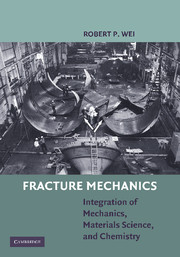Book contents
- Frontmatter
- Contents
- Preface
- Acknowledgments
- 1 Introduction
- 2 Physical Basis of Fracture Mechanics
- 3 Stress Analysis of Cracks
- 4 Experimental Determination of Fracture Toughness
- 5 Fracture Considerations for Design (Safety)
- 6 Subcritical Crack Growth: Creep-Controlled Crack Growth
- 7 Subcritical Crack Growth: Stress Corrosion Cracking and Fatigue Crack Growth (Phenomenology)
- 8 Subcritical Crack Growth: Environmentally Enhanced Crack Growth under Sustained Loads (or Stress Corrosion Cracking)
- 9 Subcritical Crack Growth: Environmentally Assisted Fatigue Crack Growth (or Corrosion Fatigue)
- 10 Science-Based Probability Modeling and Life Cycle Engineering and Management
- APPENDIX: Publications by R. P. Wei and Colleagues
- References
3 - Stress Analysis of Cracks
Published online by Cambridge University Press: 05 June 2012
- Frontmatter
- Contents
- Preface
- Acknowledgments
- 1 Introduction
- 2 Physical Basis of Fracture Mechanics
- 3 Stress Analysis of Cracks
- 4 Experimental Determination of Fracture Toughness
- 5 Fracture Considerations for Design (Safety)
- 6 Subcritical Crack Growth: Creep-Controlled Crack Growth
- 7 Subcritical Crack Growth: Stress Corrosion Cracking and Fatigue Crack Growth (Phenomenology)
- 8 Subcritical Crack Growth: Environmentally Enhanced Crack Growth under Sustained Loads (or Stress Corrosion Cracking)
- 9 Subcritical Crack Growth: Environmentally Assisted Fatigue Crack Growth (or Corrosion Fatigue)
- 10 Science-Based Probability Modeling and Life Cycle Engineering and Management
- APPENDIX: Publications by R. P. Wei and Colleagues
- References
Summary
Traditionally, design engineers prefer to work with stresses rather than energy, or energy release rates. As such, a shift in emphasis from energy to the stress analysis approach was made in the late 1950s, starting with Irwin's paper, published in the Journal of Applied Mechanics of ASME. In this paper, Irwin demonstrated the equivalence between the stress analysis and strain energy release rate approaches. This seminal work was followed by a wealth of papers over the succeeding decades that provided linear elasticity-based, stress intensity factor solutions for cracks and loadings of nearly every conceivable shape and form. Analytical (or closed-form) solutions were obtained for the simpler geometries and configurations, and numerical solutions were provided, or could be readily obtained with modern finite-element analysis codes, for the more complex cases. Most of the solutions are available in handbooks (e.g., Sih; Tada et al.; Broek). Others can be obtained by superposition, or through the use of computational techniques.
Most of the crack problems that have been solved are based on two-dimensional, linear elasticity (i.e., the infinitesimal or small strain theory for elasticity). Some three-dimensional problems have also been solved; however, they are limited principally to axisymmetric cases. Complex variable techniques have served well in the solution of these problems. To gain a better appreciation of the problems of fracture and crack growth, it is important to understand the basic assumptions and ramifications that underlie the stress analysis of cracks.
- Type
- Chapter
- Information
- Fracture MechanicsIntegration of Mechanics, Materials Science and Chemistry, pp. 26 - 49Publisher: Cambridge University PressPrint publication year: 2010



